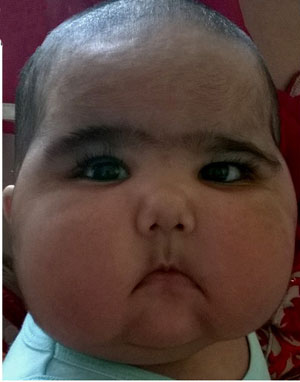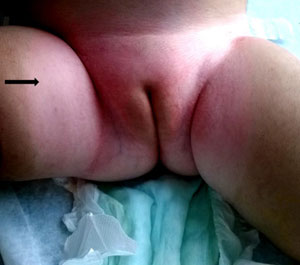|
|
|
Indian Pediatr 2016;53: 7 6-77 |
 |
Exogenous Cushing Syndrome due to Topical
Clobetasone use for Diaper Rash
|
|
*Ganesh Jevalikar and Ojasvini Sharma
Division of Endocrinology and Diabetes, Medanta, The
Medicity, Gurgaon, Haryana, India.
Email: gjevalikar@gmail.com
|
|
Inadvertent use of topical corticosteroids can be associated with
systemic side effects, more so in infants and children due to their
higher total body surface area-to-weight ratio and thinner skin [1]. We
report a case with exogenous Cushing syndrome due to application of
topical steroids for diaper rash.
An 8-month-old girl presented with prominent cheeks
and excessive facial hairs. Birth weight was 2.6 kg. Caloric intake was
normal. Parents denied medications, except oral calcium. Her weight was
8.2 kg (just above 50 th
centile), length was 63.5 cm (<3rd
centile), and blood pressure was 86/60 mm Hg. Cushingoid facies,
hypertrichosis (Fig. 1a) and hypopigmentation in
diaper area (Fig. 1b) were noted. Topical
application of a cream (containing 0.05% clobetasol propionate,
gentamicin and miconazole) in diaper area and buttocks for last 3 months
was reported by parents. A low 8 AM serum cortisol (0.22 µg/dL, normal
4.5- 22.6) with low ACTH (5.9 pg/mL, normal <46 pg/mL) confirmed the
diagnosis of exogenous Cushing syndrome. The use of the cream was
discontinued and replacement hydrocortisone was given in the dose of 6
mg/m2/day. After 3 months,
improved facial appearance, skin pigmentation, and recovery of serum
cortisol (10.9 µg/dL) was documented.

(a) |
| |
| |

(b) |
|
Fig. 1 Cushingoid facies (a), and hypopigmentation in
diaper area (b) due to topical clobetasol use.
|
Clobetasol, a superpotent topical corticosteroid, is
the most frequently described topical agent to cause Cushing syndrome
[2]. Application for even couple of weeks can cause systemic toxicity
[3]. Most cases are related to its use in diaper dermatitis, as the
occlusive effect of the diaper and underlying inflammation increase
systemic absorption. Female preponderance of cases indicates additional
absorption from vaginal mucosa [3].
Most cases of diaper dermatitis can be managed with
frequent change of diapers, periods of "rest" from diaper use, and
application of a protective barrier agent containing petroleum or zinc
oxide. If deemed necessary, low potency topical steroids (e.g.
2.5% hydrocortisone) may be used for a short period of time (3-5 days)
[4]. Use of finger-tip units (FTU) can guide the amount of topical
medication [5]. Using high potency steroids (clobetasol, betamethasone)
is inappropriate.
If adrenal suppression is noted following topical
steroid use, replacement hydrocortisone should be given and dose
enhancement during stress (fever, trauma, surgery) should be explained
to parents.
References
1. Hengge UR, Ruzicka T, Schwartz RA, Cork MJ.
Adverse effects of topical glucocorticosteroids. J Am Acad Dermatol.
2006;54:1-15.
2. Tempark T, Phatarakijnirund V, Chatproedprai S,
Watcharasindhu S, Supornsilchai V, Wananukul S. Exogenous Cushing’s
syndrome due to topical corticosteroid application: case report and
review literature. Endocrine. 2010;38:328-34.
3. Sattar H, Manzoor J, Mirza L, Sheikh AM, Butt TA.
Iatrogenic Cushing’s syndrome in children presenting at Children’s
Hospital Lahore using nappy rash ointments. J Pak Med Assoc.
2015;65:463-6.
4. Humphrey SR, Drolet BA. Principles of Therapy.
In: Kliegman RM, Stanton BF, St Jeme JW, Schor NF, editors. Nelson
Textbook of Pediatrics. 20th ed. Philadelphia: Elsevier;2015. p.2608-10.
5. Long CC, Mills CM, Finlay AY. A practical guide to topical therapy
in children. Br J Dermatol.1998;138:293-6.
|
|
|
 |
|

